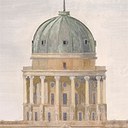0217 Ideologische Positionen zur Problematik der Budapester Burgruine in den 1950er Jahren
Identifiers (Article)
Identifiers (Files)
Abstract
Buda Castle, the Royal Palace on the Castle Hill of Budapest, was left in ruins by World War II. It was only in 1949, when the castle was destined to house the new communist government, that plans for its reconstruction were initiated. The architects involved had to deal with a historical heritage that was for the most part disliked by the new political system. This paper analyzes the positions of the protagonists in the debate on the reconstruction of the castle before and after the Hungarian Uprising in 1956. This debate moved between the poles of communist ideology, continuities of a pre-war fascist critique of modernism and a national legitimisation of the Habsburg past perceived as ‘colonial’.
Statistics


License

This work is licensed under a Creative Commons Attribution-NonCommercial-NoDerivatives 4.0 International License.



